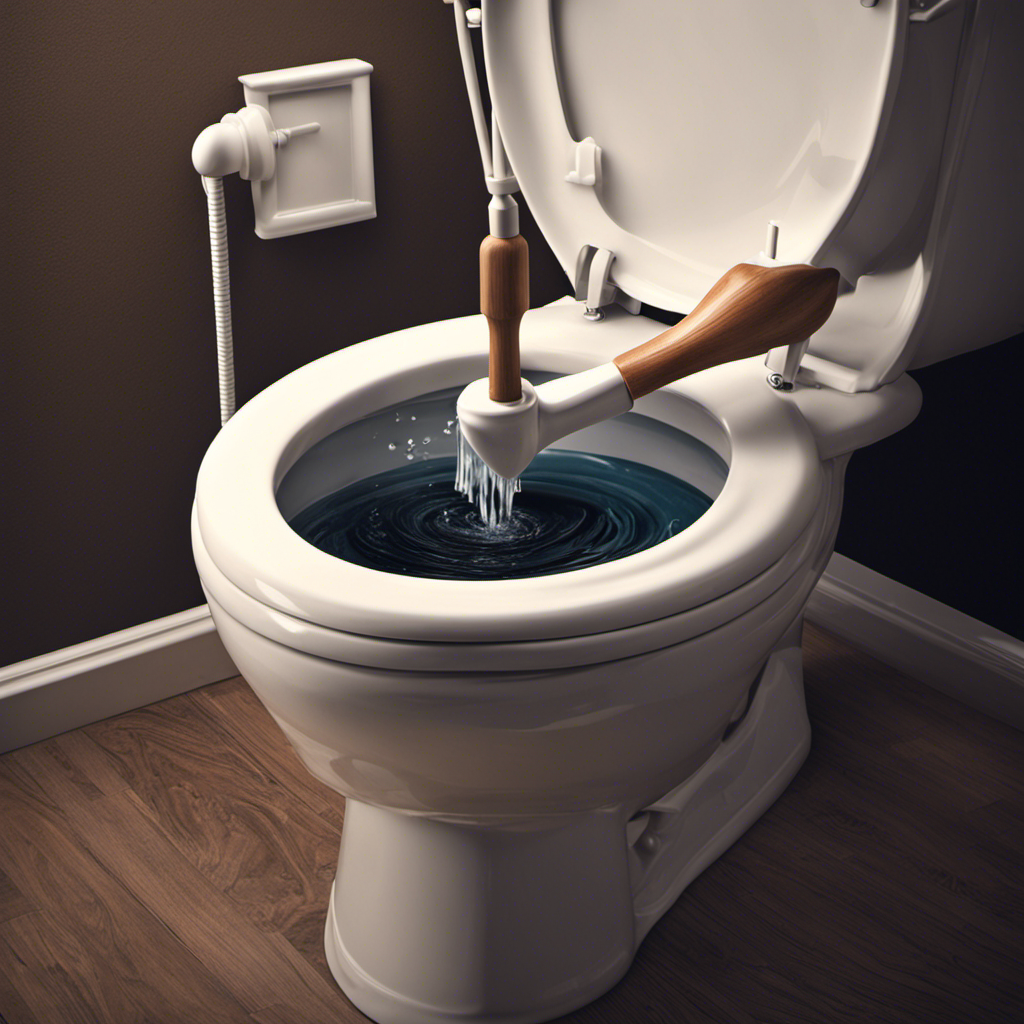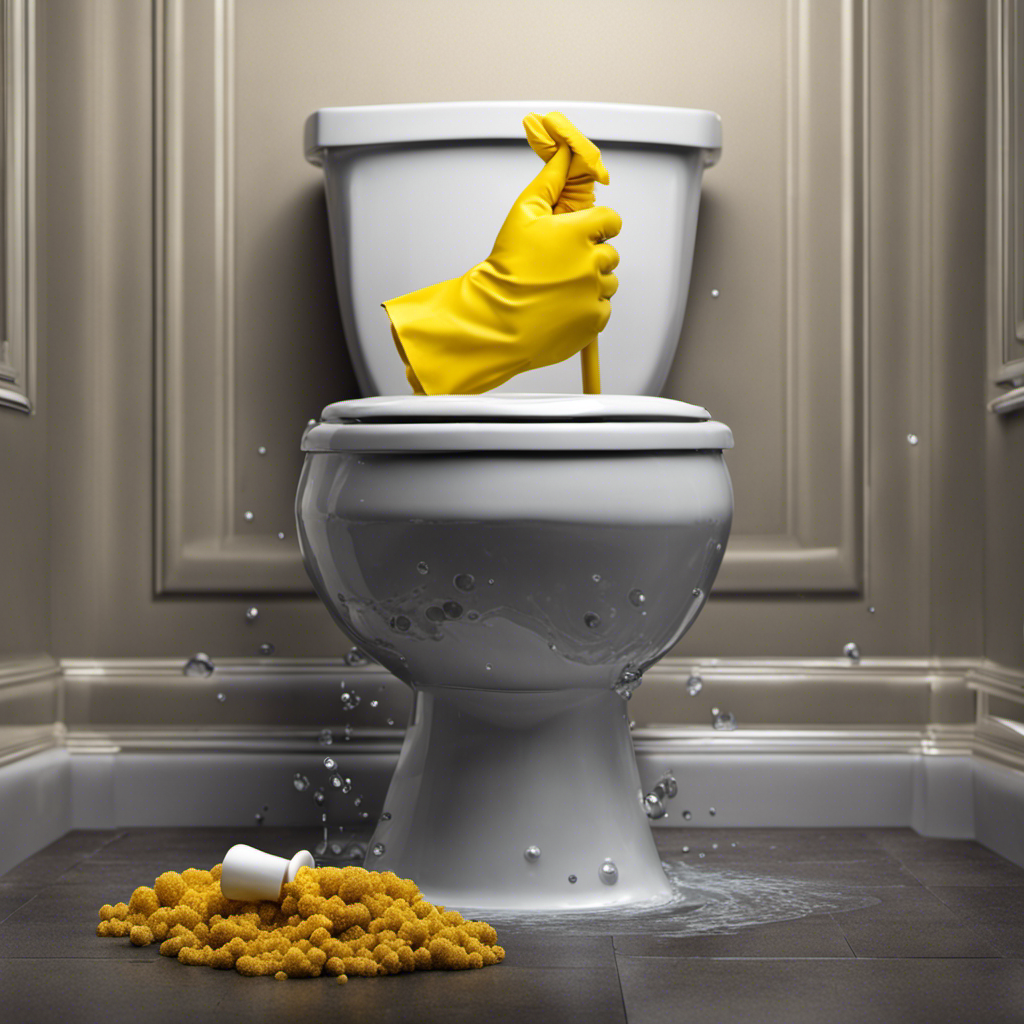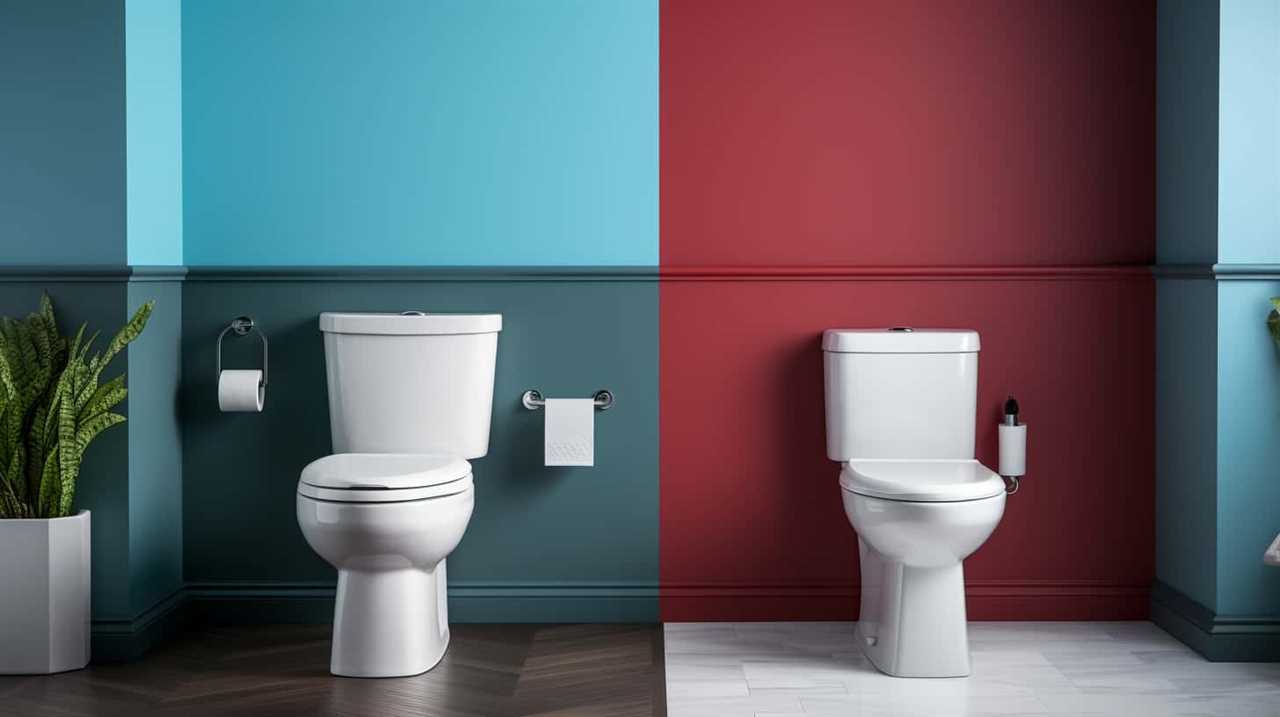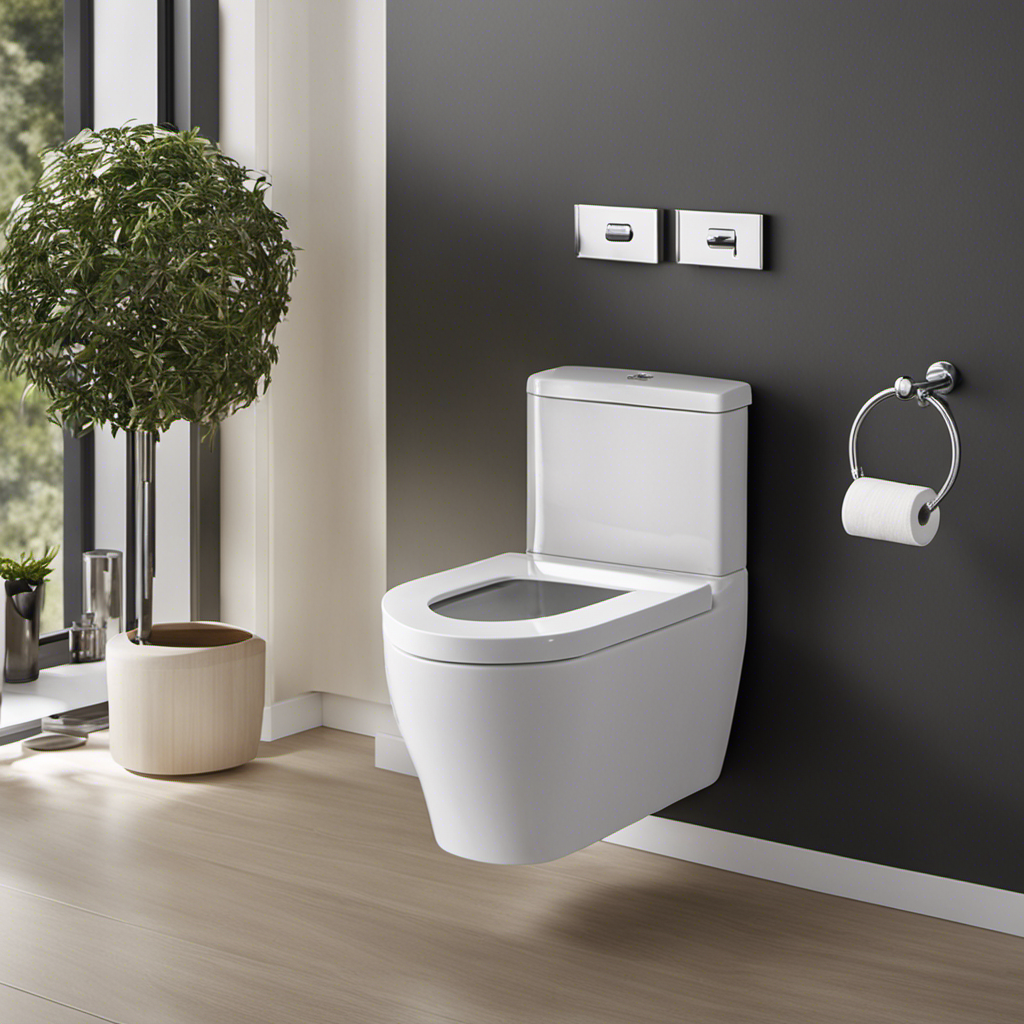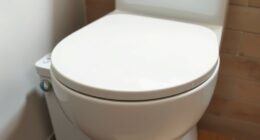Are you tired of dealing with a weak flushing toilet that just won’t get the job done? Well, fret no more! In this article, I will guide you through the step-by-step process of fixing this frustrating problem.
We will assess the water supply, check the fill valve, inspect the flapper, and even clean the rim holes.
By the end, you’ll have the knowledge and skills to confidently tackle any weak flushing toilet issue.
So, let’s get started and make your toilet flush like new again!
Key Takeaways
- Low water pressure can cause weak flushing, so it is important to check the water pressure in the home.
- Inspecting and cleaning the fill valve can help regulate water flow into the tank and improve flushing strength.
- Checking and adjusting the flapper and chain length is crucial to ensure a smooth opening and closing of the flush valve.
- Cleaning the rim holes and unclogging them is necessary to restore water pressure and prevent weak flushes.
Assess the Water Supply
First, you need to check if the water supply is causing the weak flushing in your toilet. Start by examining the water pressure in your home. Low water pressure can lead to inadequate flushing.
To assess the water pressure, turn on a faucet in your house and observe the flow. If the water pressure is low throughout your home, it may be a problem with the main water supply or the pressure regulator. However, if the water pressure is normal in other areas, the issue may be specific to your toilet.
In this case, check for clogged pipes. Buildup and debris can restrict the flow of water, resulting in weak flushing. Inspect the pipes for any obstructions and clean them if necessary.
Check the Fill Valve
To troubleshoot the issue, it’s important to start by checking the fill valve. The fill valve is responsible for regulating the water flow into the toilet tank, ensuring it fills up to the appropriate level for a proper flush. If the fill valve is not functioning correctly, it can result in a weak flushing toilet.
To check the fill valve, first, locate it inside the tank. It is usually a vertical tube attached to the bottom of the tank. Next, inspect the valve for any signs of damage or wear. If you notice any cracks or leaks, a fill valve replacement may be necessary.
If the fill valve appears to be in good condition, you can try adjusting it. Some fill valves have an adjustable float that controls the water level. By turning the adjustment screw, you can raise or lower the float, which may help improve the flushing strength.
If adjusting or replacing the fill valve does not solve the issue, it may be necessary to consult a professional plumber for further assistance.
Inspect the Flapper
When inspecting the flapper, you should check for any signs of damage or wear. The flapper is an essential component of your toilet’s flushing mechanism, responsible for sealing the flush valve and allowing water to fill the bowl.
Troubleshooting flapper issues can help resolve weak flushing problems. Start by examining the flapper for cracks, tears, or any deformities that may affect its performance. Additionally, check the chain connecting the flapper to the flush handle. Ensure it is properly attached and allows the flapper to open and close smoothly.
If you notice any damage or wear, it may be necessary to replace the flapper parts. Choose a flapper that is compatible with your toilet model and follow the manufacturer’s instructions for installation. Replacing a worn-out flapper can improve the flushing power and prevent water wastage.
Adjust the Chain Length
When troubleshooting a weak flush in a toilet, one of the key points to consider is the optimal chain length. The chain length refers to the length of the chain that connects the flapper to the flush lever.
If the chain is too long, it can prevent the flapper from fully opening, resulting in a weak flush. Adjusting the chain length to the optimal size can help ensure a strong and efficient flush.
Optimal Chain Length
The optimal chain length for a weak flushing toilet is usually around 1 to 2 inches. This ensures that the chain is neither too loose nor too tight, allowing it to effectively operate the flush mechanism. Proper chain maintenance is crucial for maintaining a strong flush.
If the chain is too long, it can get tangled or caught in the flushing mechanism, resulting in a weak flush. On the other hand, if the chain is too short, it can prevent the flush valve from fully opening, again leading to a weak flush.
Water pressure also plays a role in the effectiveness of the flush. Insufficient water pressure can hinder the flushing process, even if the chain length is optimal.
In the next section, we will explore troubleshooting weak flushes in more detail.
Troubleshooting Weak Flush
Now that we have discussed the optimal chain length for a flushing toilet, let’s move on to troubleshooting a weak flush.
One common cause of a weak flush is improper water pressure. To adjust the water pressure, locate the water supply valve, usually located near the base of the toilet. Turn the valve clockwise to decrease the water pressure or counterclockwise to increase it.
Another possible cause of a weak flush is a clog in the toilet or the drain pipe. To check for clogs, use a plunger to create suction and dislodge any blockages. If the plunger doesn’t work, try using a toilet auger to remove the clog.
Clean the Rim Holes
When it comes to maintaining proper toilet functionality, it’s crucial to address issues such as blocked rim holes, water flow restriction, and mineral deposits buildup.
Blocked rim holes can impede the flow of water, leading to a weak flush and ineffective cleaning of the bowl.
Water flow restriction can occur due to various reasons, such as a faulty flapper or a clogged toilet trap, resulting in reduced flushing power.
Additionally, mineral deposits buildup can accumulate over time, causing blockages and reducing the efficiency of the flushing mechanism.
Blocked Rim Holes
First, you’ll want to check if the rim holes are blocked in your toilet. If they are, it can contribute to a weak flushing toilet. Here are some techniques you can use to unblock the rim holes and restore proper water pressure:
-
Use a wire hanger: Straighten out a wire hanger and bend one end into a small hook. Insert the hook into each rim hole and gently move it back and forth to dislodge any debris.
-
Vinegar and baking soda: Mix equal parts vinegar and baking soda to create a foaming solution. Pour it into the rim holes and let it sit for a few hours. Then, use a toilet brush to scrub the holes and flush the toilet.
-
High-pressure water: Use a handheld bidet or a high-pressure nozzle attachment to direct water into the rim holes and dislodge any blockages.
Water Flow Restriction
To improve the water flow in your toilet, you may need to check for any restrictions.
One common cause of restricted water flow is a clogged or partially blocked water supply line.
Start by turning off the water supply valve behind the toilet.
Next, disconnect the supply line from the toilet tank and use a bucket to catch any water that may spill out.
Inspect the supply line for any debris or buildup and remove it if necessary.
Additionally, check the fill valve and make sure it is functioning properly.
If the water pressure is low, you may need to optimize it by adjusting the shut-off valve or installing a pressure regulator.
Regular maintenance and attention to flushing mechanism efficiency will help ensure a strong and efficient water flow in your toilet.
Mineral Deposits Buildup
One way you can address mineral deposit buildup is by using a descaling solution to dissolve the deposits in the toilet tank and bowl. This solution is specifically designed to break down and remove the mineral deposits, preventing further buildup and improving the overall performance of your toilet.
Here are three effective toilet maintenance tricks to prevent mineral deposits:
- Regularly clean your toilet using a descaling solution
- Install a water softener to reduce mineral content in the water
- Use a toilet tank tablet that helps prevent mineral buildup
Clear the Siphon Jet
Clearing the siphon jet is crucial for improving the flushing power of your toilet. The siphon jet, located at the bottom of the toilet bowl, is responsible for creating the necessary suction to remove waste effectively.
Over time, mineral deposits and debris can accumulate in the siphon jet, causing it to become clogged and reducing the flushing power.
To clear the siphon jet and unclog the toilet, start by turning off the water supply and flushing the toilet to empty the tank. Use a toilet brush to scrub the siphon jet and remove any visible debris.
For stubborn clogs, a mixture of hot water and vinegar can be poured into the siphon jet to dissolve mineral deposits.
Replace the Flush Valve
Make sure you turn off the water supply before replacing the flush valve in your toilet. This is an essential step to ensure your safety and prevent any water damage.
Here are some key points to keep in mind during the flush valve replacement process:
-
Gather the necessary tools: You will need an adjustable wrench, a flathead screwdriver, and a new flush valve.
-
Empty the tank: Flush the toilet and hold down the handle to drain all the water from the tank.
-
Remove the old flush valve: Unscrew the mounting nut securing the old flush valve and lift it out of the tank.
Replacing the flush valve in your toilet can be a simple DIY task that can solve issues like weak flushing. By following these steps and using the right tools, you can successfully complete the repair and restore your toilet’s optimal functionality.
Conclusion
So there you have it, folks! By following these simple steps, you’ll be able to transform your weak flushing toilet into a powerful force to be reckoned with.
Your toilet will flush with such force that it’ll feel like a mini hurricane is passing through your bathroom! Say goodbye to those frustrating moments of having to flush multiple times or deal with clogged toilets.
With these expert tips, you’ll be the master of toilet flushing in no time.
Happy flushing!
